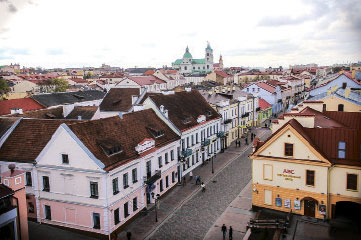
New image of restored buildings in Grodno
Architectural monuments in Grodno’s centre have been available at auction for several years, many are reaching a dangerous state of repair but there is very little funding available for restoration; however, there is a reluctance to destroy them completely. In the historic city centre there are 508 listed historic buildings in both state and private ownership, the majority of these are in a state of disrepair. Amongst them, 163 are residences requiring a large amount of expenditure. This year, only twenty houses are on the refurbishment list due to the large part of the budget taken by maintenance. Despite the lack of funding for historic monuments, it is important to find a way to preserve our heritage, even if this is to sell them on to private individuals. In 2014, fourteen auctions were held; 6 historical buildings were sold, with the condition that the historical appearance of these buildings is preserved.
The Head of the Grodno City Executive Committee’s Department of Communal Property and Privatisation, Valery Botvich, plans to put 12 state properties into the next auction — including seven architectural monuments. “A decision has been made to sell a complex of buildings formerly a border guard post, in Gorky Street, to the High-Tech Park,” he explained. “The buildings of historical-cultural value will be sold.” It is clear that a new functional modern purpose needs to be found for these buildings, which cannot be retained as mere decorative facades. Among these ancient buildings is the house at 5 Kirov Street where, in the late 19th century, Ludwik Zamenhof — founder of the Esperanto language — lived and worked. Several years ago, the building was bought by local businessman, Nikolay Shamin, and at present boasts a pleasing yellow façade painted in the original colour. “Being a city resident,” he says,” ‘I’m pleased that I’ve managed to restore the original appearance of the house. But there were several difficulties and I’m not sure I’d do the same thing all over again! We came across numerous hidden problems, a lack of qualified personnel and organisational difficulties. As a result, we had to pay much more for some of the work. Nonetheless, we’re nearing the end now so it’s time to look forward to the finish. After the interior decorating is completed we should be ready by autumn.”
It’s a challenge to rebuild historic houses under the supervision of cultural specialists. There are few advantages in monetary terms to restoring an old house; indeed, it is easier and cheaper to build a house from scratch. However, historic buildings bring their own special atmosphere and attract those who appreciate the quality of the architecture.
The Deputy Chairman of the Grodno City Executive Committee, Andrey Boltrik, is constantly searching for new owners for these houses. Whilst some businessmen have unrealistic expectations, others fail to cope with the red-tape but in spite of this, none of the buildings sold have taken advantage of the return option and, after delays and mistakes, many have been eventually restored to their full glory. In order to secure the fate of the remaining monuments, serious investors are required.
By Tatiana Ivanova











